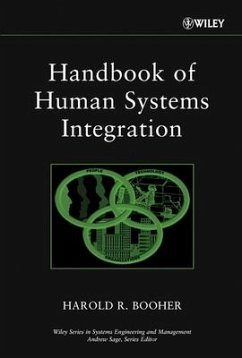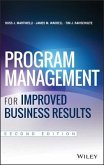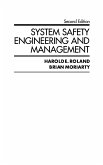- Gebundenes Buch
- Merkliste
- Auf die Merkliste
- Bewerten Bewerten
- Teilen
- Produkt teilen
- Produkterinnerung
- Produkterinnerung
A groundbreaking look at how technology with a human touch is revolutionizing government and industry
Human Systems Integration (HSI) is very attractive as a new integrating discipline designed to help move business and engineering cultures toward a more people-technology orientation. Over the past decade, the United States and foreign governments have developed a wide range of tools, techniques, and technologies aimed at integrating human factors into engineering systems in order to achieve important cost and performance benefits that otherwise would not have been accomplished. In order…mehr
Andere Kunden interessierten sich auch für
![Program Management for Improved Business Results Program Management for Improved Business Results]() Russ J MartinelliProgram Management for Improved Business Results71,99 €
Russ J MartinelliProgram Management for Improved Business Results71,99 €![Controlling Technology Controlling Technology]() Stephen H UngerControlling Technology139,99 €
Stephen H UngerControlling Technology139,99 €![Facilities Planning Facilities Planning]() James A TompkinsFacilities Planning251,99 €
James A TompkinsFacilities Planning251,99 €![Advances in Manufacturing Technology XV Advances in Manufacturing Technology XV]() DT PhamAdvances in Manufacturing Technology XV750,99 €
DT PhamAdvances in Manufacturing Technology XV750,99 €![System Safety Engineering and Management System Safety Engineering and Management]() Harold E RolandSystem Safety Engineering and Management217,99 €
Harold E RolandSystem Safety Engineering and Management217,99 €![Management of Technology and Operations Management of Technology and Operations]() R Ray GehaniManagement of Technology and Operations154,99 €
R Ray GehaniManagement of Technology and Operations154,99 €![Organization and Management of Advanced Manufacturing Organization and Management of Advanced Manufacturing]() Organization and Management of Advanced Manufacturing197,99 €
Organization and Management of Advanced Manufacturing197,99 €-
-
-
A groundbreaking look at how technology with a human touch is revolutionizing government and industry
Human Systems Integration (HSI) is very attractive as a new integrating discipline designed to help move business and engineering cultures toward a more people-technology orientation. Over the past decade, the United States and foreign governments have developed a wide range of tools, techniques, and technologies aimed at integrating human factors into engineering systems in order to achieve important cost and performance benefits that otherwise would not have been accomplished. In order for this new discipline to be effective, however, a cultural change is needed that must start with organizational leadership.
Handbook of Human Systems Integration outlines the principles and methods that can be used to help integrate people, technology, and organizations with a common objective toward designing, developing, and operating systems effectively and efficiently. Handbook of Human Systems Integration is broad in scope, covering both public and commercial processes as they interface with systems engineering processes. Emphasizing the importance of management and organization concepts as well as the technical uniqueness of HSI, Handbook of Human Systems Integration features:
More than ninety contributors, technical advisors, and reviewers from government, industry, and academia
Comprehensive coverage of the most recent HSI developments, particularly in presenting the cutting-edge tools, techniques, and methodologies utilized by each of the HSI domains
Chapters representing the governments and industries of the United Kingdom and Canada
Contributions from three services of the Department of Defense along with the Federal Aviation Administration and the National Academy of Sciences
Many chapters covering both military and nonmilitary applications
Concepts widely used by government contractors both in the United States and abroad
This book will be of special interest to HSI practitioners, systems engineers, and managers, as well as government and industry decision-makers who must weigh the recommendations of all multidisciplines contributing to systems performance, safety, and costs in order to make sound systems acquisition decisions.
Human Systems Integration (HSI) is very attractive as a new integrating discipline designed to help move business and engineering cultures toward a more people-technology orientation. Over the past decade, the United States and foreign governments have developed a wide range of tools, techniques, and technologies aimed at integrating human factors into engineering systems in order to achieve important cost and performance benefits that otherwise would not have been accomplished. In order for this new discipline to be effective, however, a cultural change is needed that must start with organizational leadership.
Handbook of Human Systems Integration outlines the principles and methods that can be used to help integrate people, technology, and organizations with a common objective toward designing, developing, and operating systems effectively and efficiently. Handbook of Human Systems Integration is broad in scope, covering both public and commercial processes as they interface with systems engineering processes. Emphasizing the importance of management and organization concepts as well as the technical uniqueness of HSI, Handbook of Human Systems Integration features:
More than ninety contributors, technical advisors, and reviewers from government, industry, and academia
Comprehensive coverage of the most recent HSI developments, particularly in presenting the cutting-edge tools, techniques, and methodologies utilized by each of the HSI domains
Chapters representing the governments and industries of the United Kingdom and Canada
Contributions from three services of the Department of Defense along with the Federal Aviation Administration and the National Academy of Sciences
Many chapters covering both military and nonmilitary applications
Concepts widely used by government contractors both in the United States and abroad
This book will be of special interest to HSI practitioners, systems engineers, and managers, as well as government and industry decision-makers who must weigh the recommendations of all multidisciplines contributing to systems performance, safety, and costs in order to make sound systems acquisition decisions.
Produktdetails
- Produktdetails
- Verlag: Wiley & Sons
- Seitenzahl: 992
- Erscheinungstermin: 7. Juli 2003
- Englisch
- Abmessung: 258mm x 182mm x 49mm
- Gewicht: 1885g
- ISBN-13: 9780471020530
- ISBN-10: 0471020532
- Artikelnr.: 11437615
- Herstellerkennzeichnung
- Libri GmbH
- Europaallee 1
- 36244 Bad Hersfeld
- gpsr@libri.de
- Verlag: Wiley & Sons
- Seitenzahl: 992
- Erscheinungstermin: 7. Juli 2003
- Englisch
- Abmessung: 258mm x 182mm x 49mm
- Gewicht: 1885g
- ISBN-13: 9780471020530
- ISBN-10: 0471020532
- Artikelnr.: 11437615
- Herstellerkennzeichnung
- Libri GmbH
- Europaallee 1
- 36244 Bad Hersfeld
- gpsr@libri.de
HAROLD R. BOOHER, PhD, is a consultant on human systems integration and MANPRINT applications to systems design, development, and assessment. Dr. Booher was the first Senior Executive (SES) Director of MANPRINT for the Department of the Army and is Editor of MANPRINT: An Approach to Systems Intergration. He has more than thirty-five years? experience in human factors and engineering in government, industry, and academic applications, and is a Fellow of the Human Factors and Ergonomics Society.
Foreword xiii
Preface xv
Contributors xix
Technical Advisors and Reviewers xxv
Chapter 1. Introduction: Human Systems Integration 1
Harold R. Booher
1.1 Background 1
1.2 HSI Concept 4
1.3 Sociotechnical Systems Complexity 9
1.4 HSI Unique Aspects 11
1.5 Ten HSI Principles 12
1.6 HSI Principles Applied to Systems Acquisition 18
1.7 HSI Organizational Maturity 21
1.8 Discussion and Summary 23
1.9 Book Overview 27
Part 1 Organization, Management, and Culture 31
Chapter 2. Leadership That Achieves Human Systems Integration 33
Charles S. Harris
Betty K. Hart
Joyce Shields
2.1 Introduction: Beyond Reductionism 33
2.2 Importance of Culture 34
2.3 Leadership Matters 37
2.4 Transformational Change Model 39
2.5 Phase 1: Decide to Change 39
2.6 Phase 2: Guide Change 45
2.7 Phase 3: Support Change 49
2.8 Phase 4: Sustain Change 54
2.9 Overcoming Challenges to Change 58
2.10 Conclusion 59
Chapter 3. Human Systems Integration Roles in a Systems Acquisition Culture
63
Glen Hewitt
Dino Piccione
3.1 Introduction 63
3.2 Common Cultural Influences 66
3.3 Historical Perspective of Culture 73
3.4 Changing Acquisition Culture 80
3.5 Trends for the Future of HSI 85
3.6 HSI Cultural Myths versus Realities 86
3.7 Roles and Responsibilities 90
3.8 Summary and Conclusions 90
Appendix: HSI Roles and Responsibilities 92
Chapter 4. Human Systems Integration and Systems Acquisition Interfaces 101
Edwin R. Smootz
4.1 Introduction 101
4.2 Systems Acquisition Processes 102
4.3 Presystems Acquisition 108
4.4 Systems Acquisition 112
4.5 Sustainment 117
4.6 Conclusion 117
Chapter 5. Human Systems Integration Education and Training 121
Brian M. Kleiner
Harold R. Booher
5.1 Introduction 121
5.2 HSI Competencies Needed 122
5.3 Academic Education 126
5.4 Textbooks 140
5.5 HSI Training Courses 147
5.6 HSI Careers 149
5.7 HSI Professional Personnel Supply 157
5.8 Summary and Conclusions 160
Part II Systems Acquisition and Management Processes 165
Chapter 6. Human Systems Integration Requirements in Systems Acquisition
167
John A. Harrison
Melanie J. Forster
6.1 Introduction 167
6.2 Human Systems Integration in Requirements 169
6.3 Human Systems Integration Requirements Issues 177
6.4 United Kingdom HFI Process 189
6.5 Summary and Conclusions 198
Chapter 7. Human Systems Integration and Acquisition: Contractor's
Perspective 201
Bruce E. Hamilton
7.1 Introduction 201
7.2 Stages of Procurement Activity 202
7.3 Principal Documentation Events of Acquisition 219
7.4 HSI Program Management Guidelines 225
7.5 Summary 230
Chapter 8. Human System Measurements and Trade-offs in System Design 233
Michael Barnes
David Beevis
8.1 Introduction 233
8.2 Human System Measurement 233
8.3 General Measurement Model for HSI 238
8.4 Analytical and Modeling Techniques Early in Design Process 244
8.5 Human Performance Experimentation 246
8.6 Modeling and Simulation 248
8.7 Interactions among HSI Domains 253
8.8 Future Trends 258
8.9 Summary and Conclusion 259
Chapter 9. Simulation-Based Acquisition 265
Stephen R. Olson
Andrew P. Sage
9.1 Introduction 265
9.2 Objectives for SBA 269
9.3 Simulation-Based Acquisition: Structure, Function, and Purpose 273
9.4 An SBA Approach to Human Systems Integration 277
9.5 SBA Quality Assurance Questions 287
9.6 Conclusion 290
Chapter 10. User-Centered Systems Engineering Framework 295
Lee Scott Ehrhart
Andrew P. Sage
10.1 Introduction 295
10.2 Models for HSI 301
10.3 System Definition 302
10.4 System Requirements 305
10.5 System Conceptual and Architectural Design 338
10.6 Prototyping and Implementation 355
10.7 System Evaluation 360
10.8 Summary and Conclusions 365
Part III Methods, Tools and Technologies 375
Chapter 11. Manpower, Personnel, and Training Integration Methods and Tools
379
Susan Archer
Donald Headley
Laurel Allender
11.1 Introduction: Workforce Challenges 379
11.2 Manpower, Personnel and Training Domains 382
11.3 MPT Systems Integration Tools 399
11.4 Commercial Applications 419
11.5 Conclusion: Challenges for MPT Integration Technologies 424
Chapter 12. Integrating Training into the Design and Operation of Complex
Systems 433
Lawrence J. Hettinger
12.1 Introduction 433
12.2 Traditional Training Model 436
12.3 HSI Training Model 439
12.4 Issues and Challenges 447
12.5 Conclusions and Recommendations 456
Chapter 13. Human Factors Engineering Methods and Tools 463
John Lockett
Jeffrey Powers
13.1 Introduction 463
13.2 Human Factors Engineering Methods 464
13.3 HFE Tools and Technologies 474
13.4 Selecting Tools and Technologies 480
13.5 Planning for Analysis 482
13.6 Common Errors in Performing HFE 487
13.7 Benefits of Modeling for HFE 492
13.8 Summary 493
Chapter 14. System Safety Principles and Methods 497
Donald W. Swallom
Robert M. Lindberg
Tonya L. Smith-Jackson
14.1 Introduction 497
14.2 Risk Assessment Model 501
14.3 System Safety Methods and Techniques 507
14.4 System Safety Process 525
14.5 Conclusion 536
Chapter 15. Environmental Health Hazard Analysis and Assessment 541
Welford C. Roberts
15.1 Introduction 541
15.2 Health Hazard Categories 545
15.3 Tools and Techniques 561
15.4 Health Hazard Assessment Expertise 576
15.5 Health Hazard Analysis Process 579
15.6 Tools That Support the Overall Health Hazard Assessment Process 581
15.7 Summary 584
Chapter 16. Personnel Survivability Methodology 595
Richard N. Zigler
Ronald A. Weiss
16.1 Introduction 595
16.2 Parameter Assessment List 597
16.3 Survivability Analysis Process 598
16.4 Personnel Survivability Components 600
16.5 Some ''Less-than-Obvious'' Examples 622
16.6 Casualty Assessment Tools 624
16.7 Summary and Conclusions 627
Chapter 17. Cost-Benefit Analysis for Human Systems Integration 631
William B. Rouse
Kenneth R. Boff
17.1 Introduction 631
17.2 Cost-Benefit Frameworks 633
17.3 Cost-Benefit Methodology 641
17.4 Three Examples 645
17.5 Conclusions 655
Part IV Applications 659
Chapter 18. Human Systems Integration in Army Systems Acquisition 663
Harold R. Booher
James Minninger
18.1 Background 663
18.2 HSI System Success Factors 664
18.3 HSI Factors: Examples from Army Systems 665
18.4 Case Studies of System Benefits 677
18.5 HSI Factors and Future Weapons Systems Acquisition 690
18.6 Summary and Conclusions 695
Chapter 19. Human Characteristics and Measures in Systems Design 699
Nita Lewis Miller
J. Jeffrey Crowson, Jr.
Jennifer McGovern Narkevicius
19.1 Introduction 699
19.2 Human Traits: Characteristics of Users 702
19.3 Human States: Operational and Environmental Variations 712
19.4 Human Systems Interfaces 724
19.5 Case Study 732
19.6 Summary and Conclusions 734
Chapter 20. Human-Centered Shipboard Systems and Operations 743
Glenn A. Osga
20.1 Background 743
20.2 Task-Centered Approach 746
20.3 Task Coverage Requirements 750
20.4 Human Support Task Requirements 755
20.5 Dynamic Task Requirements 762
20.6 Design by Task Requirements 771
20.7 Special Design Qualities 778
20.8 Benefits of Task-Centered Design 784
20.9 Summary and Conclusions 789
Chapter 21. Linking Human Performance Principles to Design of Information
Systems 795
Linda G. Pierce
Eduardo Salas
21.1 Background 795
21.2 Human Performance Issues 799
21.3 Human Performance Concepts and Principles 805
21.4 Guidelines and Tools for System Designers 811
21.5 Conclusion 821
Chapter 22. Human Systems Integration and Training for New Systems 829
John Klesch
William Stembler
22.1 Introduction 829
22.2 HSI Training Technology Applications 832
22.3 Training Requirements and IMI 835
22.4 HSI Applied to Training Development Process 845
22.5 Summary and Conclusions 857
Chapter 23. Air Traffic Control and Human Factors Integration 861
Anne Mavor
Christopher Wickens
23.1 Introduction 861
23.2 HFI in the Development of an Automated ATC System 864
23.3 Harmonization of Multiple Systems 870
23.4 National Airspace System: An Organizational HFI Example 871
23.5 Conclusion 873
Chapter 24. Human Systems Integration and New Product Development 877
William B. Rouse
24.1 Introduction 877
24.2 Private versus Public Development 879
24.3 Product Management Processes 884
24.4 Methods and Tools 888
24.5 Best Practices 895
24.6 Conclusions 900
Afterword 905
Appendix 923
Author Index 929
Subject Index 945
Preface xv
Contributors xix
Technical Advisors and Reviewers xxv
Chapter 1. Introduction: Human Systems Integration 1
Harold R. Booher
1.1 Background 1
1.2 HSI Concept 4
1.3 Sociotechnical Systems Complexity 9
1.4 HSI Unique Aspects 11
1.5 Ten HSI Principles 12
1.6 HSI Principles Applied to Systems Acquisition 18
1.7 HSI Organizational Maturity 21
1.8 Discussion and Summary 23
1.9 Book Overview 27
Part 1 Organization, Management, and Culture 31
Chapter 2. Leadership That Achieves Human Systems Integration 33
Charles S. Harris
Betty K. Hart
Joyce Shields
2.1 Introduction: Beyond Reductionism 33
2.2 Importance of Culture 34
2.3 Leadership Matters 37
2.4 Transformational Change Model 39
2.5 Phase 1: Decide to Change 39
2.6 Phase 2: Guide Change 45
2.7 Phase 3: Support Change 49
2.8 Phase 4: Sustain Change 54
2.9 Overcoming Challenges to Change 58
2.10 Conclusion 59
Chapter 3. Human Systems Integration Roles in a Systems Acquisition Culture
63
Glen Hewitt
Dino Piccione
3.1 Introduction 63
3.2 Common Cultural Influences 66
3.3 Historical Perspective of Culture 73
3.4 Changing Acquisition Culture 80
3.5 Trends for the Future of HSI 85
3.6 HSI Cultural Myths versus Realities 86
3.7 Roles and Responsibilities 90
3.8 Summary and Conclusions 90
Appendix: HSI Roles and Responsibilities 92
Chapter 4. Human Systems Integration and Systems Acquisition Interfaces 101
Edwin R. Smootz
4.1 Introduction 101
4.2 Systems Acquisition Processes 102
4.3 Presystems Acquisition 108
4.4 Systems Acquisition 112
4.5 Sustainment 117
4.6 Conclusion 117
Chapter 5. Human Systems Integration Education and Training 121
Brian M. Kleiner
Harold R. Booher
5.1 Introduction 121
5.2 HSI Competencies Needed 122
5.3 Academic Education 126
5.4 Textbooks 140
5.5 HSI Training Courses 147
5.6 HSI Careers 149
5.7 HSI Professional Personnel Supply 157
5.8 Summary and Conclusions 160
Part II Systems Acquisition and Management Processes 165
Chapter 6. Human Systems Integration Requirements in Systems Acquisition
167
John A. Harrison
Melanie J. Forster
6.1 Introduction 167
6.2 Human Systems Integration in Requirements 169
6.3 Human Systems Integration Requirements Issues 177
6.4 United Kingdom HFI Process 189
6.5 Summary and Conclusions 198
Chapter 7. Human Systems Integration and Acquisition: Contractor's
Perspective 201
Bruce E. Hamilton
7.1 Introduction 201
7.2 Stages of Procurement Activity 202
7.3 Principal Documentation Events of Acquisition 219
7.4 HSI Program Management Guidelines 225
7.5 Summary 230
Chapter 8. Human System Measurements and Trade-offs in System Design 233
Michael Barnes
David Beevis
8.1 Introduction 233
8.2 Human System Measurement 233
8.3 General Measurement Model for HSI 238
8.4 Analytical and Modeling Techniques Early in Design Process 244
8.5 Human Performance Experimentation 246
8.6 Modeling and Simulation 248
8.7 Interactions among HSI Domains 253
8.8 Future Trends 258
8.9 Summary and Conclusion 259
Chapter 9. Simulation-Based Acquisition 265
Stephen R. Olson
Andrew P. Sage
9.1 Introduction 265
9.2 Objectives for SBA 269
9.3 Simulation-Based Acquisition: Structure, Function, and Purpose 273
9.4 An SBA Approach to Human Systems Integration 277
9.5 SBA Quality Assurance Questions 287
9.6 Conclusion 290
Chapter 10. User-Centered Systems Engineering Framework 295
Lee Scott Ehrhart
Andrew P. Sage
10.1 Introduction 295
10.2 Models for HSI 301
10.3 System Definition 302
10.4 System Requirements 305
10.5 System Conceptual and Architectural Design 338
10.6 Prototyping and Implementation 355
10.7 System Evaluation 360
10.8 Summary and Conclusions 365
Part III Methods, Tools and Technologies 375
Chapter 11. Manpower, Personnel, and Training Integration Methods and Tools
379
Susan Archer
Donald Headley
Laurel Allender
11.1 Introduction: Workforce Challenges 379
11.2 Manpower, Personnel and Training Domains 382
11.3 MPT Systems Integration Tools 399
11.4 Commercial Applications 419
11.5 Conclusion: Challenges for MPT Integration Technologies 424
Chapter 12. Integrating Training into the Design and Operation of Complex
Systems 433
Lawrence J. Hettinger
12.1 Introduction 433
12.2 Traditional Training Model 436
12.3 HSI Training Model 439
12.4 Issues and Challenges 447
12.5 Conclusions and Recommendations 456
Chapter 13. Human Factors Engineering Methods and Tools 463
John Lockett
Jeffrey Powers
13.1 Introduction 463
13.2 Human Factors Engineering Methods 464
13.3 HFE Tools and Technologies 474
13.4 Selecting Tools and Technologies 480
13.5 Planning for Analysis 482
13.6 Common Errors in Performing HFE 487
13.7 Benefits of Modeling for HFE 492
13.8 Summary 493
Chapter 14. System Safety Principles and Methods 497
Donald W. Swallom
Robert M. Lindberg
Tonya L. Smith-Jackson
14.1 Introduction 497
14.2 Risk Assessment Model 501
14.3 System Safety Methods and Techniques 507
14.4 System Safety Process 525
14.5 Conclusion 536
Chapter 15. Environmental Health Hazard Analysis and Assessment 541
Welford C. Roberts
15.1 Introduction 541
15.2 Health Hazard Categories 545
15.3 Tools and Techniques 561
15.4 Health Hazard Assessment Expertise 576
15.5 Health Hazard Analysis Process 579
15.6 Tools That Support the Overall Health Hazard Assessment Process 581
15.7 Summary 584
Chapter 16. Personnel Survivability Methodology 595
Richard N. Zigler
Ronald A. Weiss
16.1 Introduction 595
16.2 Parameter Assessment List 597
16.3 Survivability Analysis Process 598
16.4 Personnel Survivability Components 600
16.5 Some ''Less-than-Obvious'' Examples 622
16.6 Casualty Assessment Tools 624
16.7 Summary and Conclusions 627
Chapter 17. Cost-Benefit Analysis for Human Systems Integration 631
William B. Rouse
Kenneth R. Boff
17.1 Introduction 631
17.2 Cost-Benefit Frameworks 633
17.3 Cost-Benefit Methodology 641
17.4 Three Examples 645
17.5 Conclusions 655
Part IV Applications 659
Chapter 18. Human Systems Integration in Army Systems Acquisition 663
Harold R. Booher
James Minninger
18.1 Background 663
18.2 HSI System Success Factors 664
18.3 HSI Factors: Examples from Army Systems 665
18.4 Case Studies of System Benefits 677
18.5 HSI Factors and Future Weapons Systems Acquisition 690
18.6 Summary and Conclusions 695
Chapter 19. Human Characteristics and Measures in Systems Design 699
Nita Lewis Miller
J. Jeffrey Crowson, Jr.
Jennifer McGovern Narkevicius
19.1 Introduction 699
19.2 Human Traits: Characteristics of Users 702
19.3 Human States: Operational and Environmental Variations 712
19.4 Human Systems Interfaces 724
19.5 Case Study 732
19.6 Summary and Conclusions 734
Chapter 20. Human-Centered Shipboard Systems and Operations 743
Glenn A. Osga
20.1 Background 743
20.2 Task-Centered Approach 746
20.3 Task Coverage Requirements 750
20.4 Human Support Task Requirements 755
20.5 Dynamic Task Requirements 762
20.6 Design by Task Requirements 771
20.7 Special Design Qualities 778
20.8 Benefits of Task-Centered Design 784
20.9 Summary and Conclusions 789
Chapter 21. Linking Human Performance Principles to Design of Information
Systems 795
Linda G. Pierce
Eduardo Salas
21.1 Background 795
21.2 Human Performance Issues 799
21.3 Human Performance Concepts and Principles 805
21.4 Guidelines and Tools for System Designers 811
21.5 Conclusion 821
Chapter 22. Human Systems Integration and Training for New Systems 829
John Klesch
William Stembler
22.1 Introduction 829
22.2 HSI Training Technology Applications 832
22.3 Training Requirements and IMI 835
22.4 HSI Applied to Training Development Process 845
22.5 Summary and Conclusions 857
Chapter 23. Air Traffic Control and Human Factors Integration 861
Anne Mavor
Christopher Wickens
23.1 Introduction 861
23.2 HFI in the Development of an Automated ATC System 864
23.3 Harmonization of Multiple Systems 870
23.4 National Airspace System: An Organizational HFI Example 871
23.5 Conclusion 873
Chapter 24. Human Systems Integration and New Product Development 877
William B. Rouse
24.1 Introduction 877
24.2 Private versus Public Development 879
24.3 Product Management Processes 884
24.4 Methods and Tools 888
24.5 Best Practices 895
24.6 Conclusions 900
Afterword 905
Appendix 923
Author Index 929
Subject Index 945
Foreword xiii
Preface xv
Contributors xix
Technical Advisors and Reviewers xxv
Chapter 1. Introduction: Human Systems Integration 1
Harold R. Booher
1.1 Background 1
1.2 HSI Concept 4
1.3 Sociotechnical Systems Complexity 9
1.4 HSI Unique Aspects 11
1.5 Ten HSI Principles 12
1.6 HSI Principles Applied to Systems Acquisition 18
1.7 HSI Organizational Maturity 21
1.8 Discussion and Summary 23
1.9 Book Overview 27
Part 1 Organization, Management, and Culture 31
Chapter 2. Leadership That Achieves Human Systems Integration 33
Charles S. Harris
Betty K. Hart
Joyce Shields
2.1 Introduction: Beyond Reductionism 33
2.2 Importance of Culture 34
2.3 Leadership Matters 37
2.4 Transformational Change Model 39
2.5 Phase 1: Decide to Change 39
2.6 Phase 2: Guide Change 45
2.7 Phase 3: Support Change 49
2.8 Phase 4: Sustain Change 54
2.9 Overcoming Challenges to Change 58
2.10 Conclusion 59
Chapter 3. Human Systems Integration Roles in a Systems Acquisition Culture
63
Glen Hewitt
Dino Piccione
3.1 Introduction 63
3.2 Common Cultural Influences 66
3.3 Historical Perspective of Culture 73
3.4 Changing Acquisition Culture 80
3.5 Trends for the Future of HSI 85
3.6 HSI Cultural Myths versus Realities 86
3.7 Roles and Responsibilities 90
3.8 Summary and Conclusions 90
Appendix: HSI Roles and Responsibilities 92
Chapter 4. Human Systems Integration and Systems Acquisition Interfaces 101
Edwin R. Smootz
4.1 Introduction 101
4.2 Systems Acquisition Processes 102
4.3 Presystems Acquisition 108
4.4 Systems Acquisition 112
4.5 Sustainment 117
4.6 Conclusion 117
Chapter 5. Human Systems Integration Education and Training 121
Brian M. Kleiner
Harold R. Booher
5.1 Introduction 121
5.2 HSI Competencies Needed 122
5.3 Academic Education 126
5.4 Textbooks 140
5.5 HSI Training Courses 147
5.6 HSI Careers 149
5.7 HSI Professional Personnel Supply 157
5.8 Summary and Conclusions 160
Part II Systems Acquisition and Management Processes 165
Chapter 6. Human Systems Integration Requirements in Systems Acquisition
167
John A. Harrison
Melanie J. Forster
6.1 Introduction 167
6.2 Human Systems Integration in Requirements 169
6.3 Human Systems Integration Requirements Issues 177
6.4 United Kingdom HFI Process 189
6.5 Summary and Conclusions 198
Chapter 7. Human Systems Integration and Acquisition: Contractor's
Perspective 201
Bruce E. Hamilton
7.1 Introduction 201
7.2 Stages of Procurement Activity 202
7.3 Principal Documentation Events of Acquisition 219
7.4 HSI Program Management Guidelines 225
7.5 Summary 230
Chapter 8. Human System Measurements and Trade-offs in System Design 233
Michael Barnes
David Beevis
8.1 Introduction 233
8.2 Human System Measurement 233
8.3 General Measurement Model for HSI 238
8.4 Analytical and Modeling Techniques Early in Design Process 244
8.5 Human Performance Experimentation 246
8.6 Modeling and Simulation 248
8.7 Interactions among HSI Domains 253
8.8 Future Trends 258
8.9 Summary and Conclusion 259
Chapter 9. Simulation-Based Acquisition 265
Stephen R. Olson
Andrew P. Sage
9.1 Introduction 265
9.2 Objectives for SBA 269
9.3 Simulation-Based Acquisition: Structure, Function, and Purpose 273
9.4 An SBA Approach to Human Systems Integration 277
9.5 SBA Quality Assurance Questions 287
9.6 Conclusion 290
Chapter 10. User-Centered Systems Engineering Framework 295
Lee Scott Ehrhart
Andrew P. Sage
10.1 Introduction 295
10.2 Models for HSI 301
10.3 System Definition 302
10.4 System Requirements 305
10.5 System Conceptual and Architectural Design 338
10.6 Prototyping and Implementation 355
10.7 System Evaluation 360
10.8 Summary and Conclusions 365
Part III Methods, Tools and Technologies 375
Chapter 11. Manpower, Personnel, and Training Integration Methods and Tools
379
Susan Archer
Donald Headley
Laurel Allender
11.1 Introduction: Workforce Challenges 379
11.2 Manpower, Personnel and Training Domains 382
11.3 MPT Systems Integration Tools 399
11.4 Commercial Applications 419
11.5 Conclusion: Challenges for MPT Integration Technologies 424
Chapter 12. Integrating Training into the Design and Operation of Complex
Systems 433
Lawrence J. Hettinger
12.1 Introduction 433
12.2 Traditional Training Model 436
12.3 HSI Training Model 439
12.4 Issues and Challenges 447
12.5 Conclusions and Recommendations 456
Chapter 13. Human Factors Engineering Methods and Tools 463
John Lockett
Jeffrey Powers
13.1 Introduction 463
13.2 Human Factors Engineering Methods 464
13.3 HFE Tools and Technologies 474
13.4 Selecting Tools and Technologies 480
13.5 Planning for Analysis 482
13.6 Common Errors in Performing HFE 487
13.7 Benefits of Modeling for HFE 492
13.8 Summary 493
Chapter 14. System Safety Principles and Methods 497
Donald W. Swallom
Robert M. Lindberg
Tonya L. Smith-Jackson
14.1 Introduction 497
14.2 Risk Assessment Model 501
14.3 System Safety Methods and Techniques 507
14.4 System Safety Process 525
14.5 Conclusion 536
Chapter 15. Environmental Health Hazard Analysis and Assessment 541
Welford C. Roberts
15.1 Introduction 541
15.2 Health Hazard Categories 545
15.3 Tools and Techniques 561
15.4 Health Hazard Assessment Expertise 576
15.5 Health Hazard Analysis Process 579
15.6 Tools That Support the Overall Health Hazard Assessment Process 581
15.7 Summary 584
Chapter 16. Personnel Survivability Methodology 595
Richard N. Zigler
Ronald A. Weiss
16.1 Introduction 595
16.2 Parameter Assessment List 597
16.3 Survivability Analysis Process 598
16.4 Personnel Survivability Components 600
16.5 Some ''Less-than-Obvious'' Examples 622
16.6 Casualty Assessment Tools 624
16.7 Summary and Conclusions 627
Chapter 17. Cost-Benefit Analysis for Human Systems Integration 631
William B. Rouse
Kenneth R. Boff
17.1 Introduction 631
17.2 Cost-Benefit Frameworks 633
17.3 Cost-Benefit Methodology 641
17.4 Three Examples 645
17.5 Conclusions 655
Part IV Applications 659
Chapter 18. Human Systems Integration in Army Systems Acquisition 663
Harold R. Booher
James Minninger
18.1 Background 663
18.2 HSI System Success Factors 664
18.3 HSI Factors: Examples from Army Systems 665
18.4 Case Studies of System Benefits 677
18.5 HSI Factors and Future Weapons Systems Acquisition 690
18.6 Summary and Conclusions 695
Chapter 19. Human Characteristics and Measures in Systems Design 699
Nita Lewis Miller
J. Jeffrey Crowson, Jr.
Jennifer McGovern Narkevicius
19.1 Introduction 699
19.2 Human Traits: Characteristics of Users 702
19.3 Human States: Operational and Environmental Variations 712
19.4 Human Systems Interfaces 724
19.5 Case Study 732
19.6 Summary and Conclusions 734
Chapter 20. Human-Centered Shipboard Systems and Operations 743
Glenn A. Osga
20.1 Background 743
20.2 Task-Centered Approach 746
20.3 Task Coverage Requirements 750
20.4 Human Support Task Requirements 755
20.5 Dynamic Task Requirements 762
20.6 Design by Task Requirements 771
20.7 Special Design Qualities 778
20.8 Benefits of Task-Centered Design 784
20.9 Summary and Conclusions 789
Chapter 21. Linking Human Performance Principles to Design of Information
Systems 795
Linda G. Pierce
Eduardo Salas
21.1 Background 795
21.2 Human Performance Issues 799
21.3 Human Performance Concepts and Principles 805
21.4 Guidelines and Tools for System Designers 811
21.5 Conclusion 821
Chapter 22. Human Systems Integration and Training for New Systems 829
John Klesch
William Stembler
22.1 Introduction 829
22.2 HSI Training Technology Applications 832
22.3 Training Requirements and IMI 835
22.4 HSI Applied to Training Development Process 845
22.5 Summary and Conclusions 857
Chapter 23. Air Traffic Control and Human Factors Integration 861
Anne Mavor
Christopher Wickens
23.1 Introduction 861
23.2 HFI in the Development of an Automated ATC System 864
23.3 Harmonization of Multiple Systems 870
23.4 National Airspace System: An Organizational HFI Example 871
23.5 Conclusion 873
Chapter 24. Human Systems Integration and New Product Development 877
William B. Rouse
24.1 Introduction 877
24.2 Private versus Public Development 879
24.3 Product Management Processes 884
24.4 Methods and Tools 888
24.5 Best Practices 895
24.6 Conclusions 900
Afterword 905
Appendix 923
Author Index 929
Subject Index 945
Preface xv
Contributors xix
Technical Advisors and Reviewers xxv
Chapter 1. Introduction: Human Systems Integration 1
Harold R. Booher
1.1 Background 1
1.2 HSI Concept 4
1.3 Sociotechnical Systems Complexity 9
1.4 HSI Unique Aspects 11
1.5 Ten HSI Principles 12
1.6 HSI Principles Applied to Systems Acquisition 18
1.7 HSI Organizational Maturity 21
1.8 Discussion and Summary 23
1.9 Book Overview 27
Part 1 Organization, Management, and Culture 31
Chapter 2. Leadership That Achieves Human Systems Integration 33
Charles S. Harris
Betty K. Hart
Joyce Shields
2.1 Introduction: Beyond Reductionism 33
2.2 Importance of Culture 34
2.3 Leadership Matters 37
2.4 Transformational Change Model 39
2.5 Phase 1: Decide to Change 39
2.6 Phase 2: Guide Change 45
2.7 Phase 3: Support Change 49
2.8 Phase 4: Sustain Change 54
2.9 Overcoming Challenges to Change 58
2.10 Conclusion 59
Chapter 3. Human Systems Integration Roles in a Systems Acquisition Culture
63
Glen Hewitt
Dino Piccione
3.1 Introduction 63
3.2 Common Cultural Influences 66
3.3 Historical Perspective of Culture 73
3.4 Changing Acquisition Culture 80
3.5 Trends for the Future of HSI 85
3.6 HSI Cultural Myths versus Realities 86
3.7 Roles and Responsibilities 90
3.8 Summary and Conclusions 90
Appendix: HSI Roles and Responsibilities 92
Chapter 4. Human Systems Integration and Systems Acquisition Interfaces 101
Edwin R. Smootz
4.1 Introduction 101
4.2 Systems Acquisition Processes 102
4.3 Presystems Acquisition 108
4.4 Systems Acquisition 112
4.5 Sustainment 117
4.6 Conclusion 117
Chapter 5. Human Systems Integration Education and Training 121
Brian M. Kleiner
Harold R. Booher
5.1 Introduction 121
5.2 HSI Competencies Needed 122
5.3 Academic Education 126
5.4 Textbooks 140
5.5 HSI Training Courses 147
5.6 HSI Careers 149
5.7 HSI Professional Personnel Supply 157
5.8 Summary and Conclusions 160
Part II Systems Acquisition and Management Processes 165
Chapter 6. Human Systems Integration Requirements in Systems Acquisition
167
John A. Harrison
Melanie J. Forster
6.1 Introduction 167
6.2 Human Systems Integration in Requirements 169
6.3 Human Systems Integration Requirements Issues 177
6.4 United Kingdom HFI Process 189
6.5 Summary and Conclusions 198
Chapter 7. Human Systems Integration and Acquisition: Contractor's
Perspective 201
Bruce E. Hamilton
7.1 Introduction 201
7.2 Stages of Procurement Activity 202
7.3 Principal Documentation Events of Acquisition 219
7.4 HSI Program Management Guidelines 225
7.5 Summary 230
Chapter 8. Human System Measurements and Trade-offs in System Design 233
Michael Barnes
David Beevis
8.1 Introduction 233
8.2 Human System Measurement 233
8.3 General Measurement Model for HSI 238
8.4 Analytical and Modeling Techniques Early in Design Process 244
8.5 Human Performance Experimentation 246
8.6 Modeling and Simulation 248
8.7 Interactions among HSI Domains 253
8.8 Future Trends 258
8.9 Summary and Conclusion 259
Chapter 9. Simulation-Based Acquisition 265
Stephen R. Olson
Andrew P. Sage
9.1 Introduction 265
9.2 Objectives for SBA 269
9.3 Simulation-Based Acquisition: Structure, Function, and Purpose 273
9.4 An SBA Approach to Human Systems Integration 277
9.5 SBA Quality Assurance Questions 287
9.6 Conclusion 290
Chapter 10. User-Centered Systems Engineering Framework 295
Lee Scott Ehrhart
Andrew P. Sage
10.1 Introduction 295
10.2 Models for HSI 301
10.3 System Definition 302
10.4 System Requirements 305
10.5 System Conceptual and Architectural Design 338
10.6 Prototyping and Implementation 355
10.7 System Evaluation 360
10.8 Summary and Conclusions 365
Part III Methods, Tools and Technologies 375
Chapter 11. Manpower, Personnel, and Training Integration Methods and Tools
379
Susan Archer
Donald Headley
Laurel Allender
11.1 Introduction: Workforce Challenges 379
11.2 Manpower, Personnel and Training Domains 382
11.3 MPT Systems Integration Tools 399
11.4 Commercial Applications 419
11.5 Conclusion: Challenges for MPT Integration Technologies 424
Chapter 12. Integrating Training into the Design and Operation of Complex
Systems 433
Lawrence J. Hettinger
12.1 Introduction 433
12.2 Traditional Training Model 436
12.3 HSI Training Model 439
12.4 Issues and Challenges 447
12.5 Conclusions and Recommendations 456
Chapter 13. Human Factors Engineering Methods and Tools 463
John Lockett
Jeffrey Powers
13.1 Introduction 463
13.2 Human Factors Engineering Methods 464
13.3 HFE Tools and Technologies 474
13.4 Selecting Tools and Technologies 480
13.5 Planning for Analysis 482
13.6 Common Errors in Performing HFE 487
13.7 Benefits of Modeling for HFE 492
13.8 Summary 493
Chapter 14. System Safety Principles and Methods 497
Donald W. Swallom
Robert M. Lindberg
Tonya L. Smith-Jackson
14.1 Introduction 497
14.2 Risk Assessment Model 501
14.3 System Safety Methods and Techniques 507
14.4 System Safety Process 525
14.5 Conclusion 536
Chapter 15. Environmental Health Hazard Analysis and Assessment 541
Welford C. Roberts
15.1 Introduction 541
15.2 Health Hazard Categories 545
15.3 Tools and Techniques 561
15.4 Health Hazard Assessment Expertise 576
15.5 Health Hazard Analysis Process 579
15.6 Tools That Support the Overall Health Hazard Assessment Process 581
15.7 Summary 584
Chapter 16. Personnel Survivability Methodology 595
Richard N. Zigler
Ronald A. Weiss
16.1 Introduction 595
16.2 Parameter Assessment List 597
16.3 Survivability Analysis Process 598
16.4 Personnel Survivability Components 600
16.5 Some ''Less-than-Obvious'' Examples 622
16.6 Casualty Assessment Tools 624
16.7 Summary and Conclusions 627
Chapter 17. Cost-Benefit Analysis for Human Systems Integration 631
William B. Rouse
Kenneth R. Boff
17.1 Introduction 631
17.2 Cost-Benefit Frameworks 633
17.3 Cost-Benefit Methodology 641
17.4 Three Examples 645
17.5 Conclusions 655
Part IV Applications 659
Chapter 18. Human Systems Integration in Army Systems Acquisition 663
Harold R. Booher
James Minninger
18.1 Background 663
18.2 HSI System Success Factors 664
18.3 HSI Factors: Examples from Army Systems 665
18.4 Case Studies of System Benefits 677
18.5 HSI Factors and Future Weapons Systems Acquisition 690
18.6 Summary and Conclusions 695
Chapter 19. Human Characteristics and Measures in Systems Design 699
Nita Lewis Miller
J. Jeffrey Crowson, Jr.
Jennifer McGovern Narkevicius
19.1 Introduction 699
19.2 Human Traits: Characteristics of Users 702
19.3 Human States: Operational and Environmental Variations 712
19.4 Human Systems Interfaces 724
19.5 Case Study 732
19.6 Summary and Conclusions 734
Chapter 20. Human-Centered Shipboard Systems and Operations 743
Glenn A. Osga
20.1 Background 743
20.2 Task-Centered Approach 746
20.3 Task Coverage Requirements 750
20.4 Human Support Task Requirements 755
20.5 Dynamic Task Requirements 762
20.6 Design by Task Requirements 771
20.7 Special Design Qualities 778
20.8 Benefits of Task-Centered Design 784
20.9 Summary and Conclusions 789
Chapter 21. Linking Human Performance Principles to Design of Information
Systems 795
Linda G. Pierce
Eduardo Salas
21.1 Background 795
21.2 Human Performance Issues 799
21.3 Human Performance Concepts and Principles 805
21.4 Guidelines and Tools for System Designers 811
21.5 Conclusion 821
Chapter 22. Human Systems Integration and Training for New Systems 829
John Klesch
William Stembler
22.1 Introduction 829
22.2 HSI Training Technology Applications 832
22.3 Training Requirements and IMI 835
22.4 HSI Applied to Training Development Process 845
22.5 Summary and Conclusions 857
Chapter 23. Air Traffic Control and Human Factors Integration 861
Anne Mavor
Christopher Wickens
23.1 Introduction 861
23.2 HFI in the Development of an Automated ATC System 864
23.3 Harmonization of Multiple Systems 870
23.4 National Airspace System: An Organizational HFI Example 871
23.5 Conclusion 873
Chapter 24. Human Systems Integration and New Product Development 877
William B. Rouse
24.1 Introduction 877
24.2 Private versus Public Development 879
24.3 Product Management Processes 884
24.4 Methods and Tools 888
24.5 Best Practices 895
24.6 Conclusions 900
Afterword 905
Appendix 923
Author Index 929
Subject Index 945








